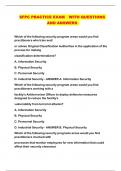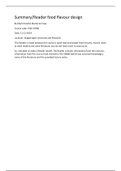Instructioneel design – samenvatting ppt
Inleiding (les 1)
Design
Design bestaat uit proces en product
Proces
o Designen als proces
o Toepassing van aanvaard(bar)e theorie, kennis, bevindingen, modellen
o Aanpassen aan context en leerder
o Analyseren van design: doelstellingen, context, achtergrondkenmerken, doelgroep
o Vormen van een hypothese die je in de real-world gaat uittesten trial and error
Product
o Gebruiksvriendelijk, goedkoop, nuttig, aanpasbaar
Covid-pandemie
Wat hebben we geleerd?
o Flexibiliteit en aanpassingsvermogen
o Technologie Nieuwe functionaliteiten maar toch nog onvoldoende geëxploiteerd
o Uitdagingen
Onderwijs = kinderopvang designers moeten beperkingen en
mogelijkheden kennen
Onderwijs = te instructiegebaseerd
De leeromgeving
Componenten
o de leerder
o de medeleerder
o de leerkracht/opleider
o de inhouden
o het onderwijsmodel
o het leermodel
o het evaluatiemodel
o infrastructuur
o media en technologie
Multimodale leeromgeving
Het leer- en instructieproces wordt gespreid over:
o autonoom leren
o collaboratief leren
o coaching
o instructie
o … met telkens:
activiteit
1
, activering
feedback
evaluatie
De optimale leeromgeving context = !
Dit zijn de keuzes die jij als designer moet maken om je designprobleem aan te pakken
Verschillende ID-modellen
3PD model , 4C-ID Model (Jeroen van Merriënboer), Action Mapping, Action Research (Participatory
Design Models), Activity Theory, ACT-R (John Anderson), Adult Learning Theory (P. Cross), Algo-
Heuristic Theory (Lev Landa), Anchored Instruction (John Bransford), Andragogy (Malcolm Knowles),
Aptitude-Treatment Interaction (L. Cronbach & R. Snow), ARCS (John Keller), ASSURE (Heinich,
Molenda, Russel, and Smaldino), Attribution Theory (B. Weiner), Backward Design (Wiggins &
McTighe), Bergman & Moore model, Bloom’s Taxonomy, Cascade model, Cognitive Apprenticeship
(Edmondson), Cognitive Dissonance Theory (L. Festinger), Cognitive Flexibility Theory (R. Spiro),
Cognitive Load Theory (J. Sweller), Collaborative learning, Complex Learning, Component Display
Theory (David Merrill), Concept mapping, Conditions of Learning (Robert Gagne), Cone of experience
(Edgar Dale), Connectionism (Edward Thorndike), Constructivist Learning Environments (CLE)-
Jonassen , Constructivist Theory (Jerome Bruner), Contiguity Theory (Edwin Guthrie), Conversation
Theory (Gordon Pask), Criterion Referenced Instruction (Robert Mager), Critical events model van
Nadler , CSILE, Dick & Carey, Discovery learning , Dorsey, Goodrum & Schwen, Double Loop Learning
(C. Argyris), Drive Reduction Theory (C. Hull), Dual Coding Theory (A. Paivio), Elaboration Theory (C.
Reigeluth), Empathic instructional design, Experiential Learning (C. Rogers), Experiential Learning
Model van Kolb , Functional Context Theory (Tom Sticht), Gagné’s Nine Events of Instruction, General
Problem Solver (A. Newell & H. Simon), Genetic Epistemology (J. Piaget), Gerlach-Ely Model, Gestalt
Theory (M. Wertheimer), Goal-based scenarios, GOMS (Card, Moran & Newell), Hannafin-Peck
Model, Human Performance Improvement , ILDF model, Individualized Instruction, Information
Pickup Theory (J.J. Gibson), Information Processing Theory (G.A. Miller), Instructional Systems Design
ISD, Integrative Learning Design Framework for Online Learning (Debbaugh), Kirk and Gustafson
Model, Lateral Thinking (E. DeBono), Learner autonomy, Learning Circle Framework, Levels of
Processing (Craik & Lockhart), Mathematical Learning Theory (R.C. Atkinson), Mathematical Problem
2
, Solving (A. Schoenfeld), McCarthy's 4MAT cycle of learning, Merrill’s Principles of Instruction (MPI),
Minimalism (J. M. Carroll), Model Centered Instruction and Design Layering (Andrew Gibbons), Model
van Romiszowski , Modes of Learning (D. Rumelhart & D. Norman), MRK model, Multiple
Intelligences (Howard Gardner), Operant Conditioning (B.F. Skinner), Organizational Elements Model
(Roger Kaufman), Originality (I. Maltzman), Performance Improvement, Phenomenonography (F.
Marton & N. Entwistle), PIE model, Problem Based Learning , Project-based learning ,
Psychomotorische vaardigheden (Romiszowski), Repair Theory (K. VanLehn), SAVI-model van D.
Meier , Script Theory (Roger Schank), Sign Theory (E. Tolman), Situated Cognition Theory, Situated
Learning (J. Lave), Soar (A. Newell et al.), Social Development (L. Vygotsky), Social Learning Theory (A.
Bandura), Sociocultural Learning Theory, SOI-model van Mayer, Spiral Model (Boehm), Stimulus
Sampling Theory (W. Estes), Structural Learning Theory (J. Scandura), Structure of Intellect (J.
Guilford), Subsumption Theory (D. Ausubel), Successive Approximation Model (SAM), Symbol
Systems (G. Salomon), System approach model van Dick en Carey , Taxonomie van Bloom ,
Transactional Distance (Michael Moore), Transformational Learning (J. Mezirow), Triarchic Theory (R.
Sternberg), Universal Design for Learning (UDL) , Wijze Lessen, Zelfdeterminatietheorie - Deci & Ryan,
Designprocesmodellen
Systematisch: ADDIE
o ADDIE = analyse design development implementation evaluation
o Kritiek: je kan niet een stapje terug nemen
Iteratief
o Rapid (ontwerper-gebruiker iteratie)
o Agile (opdeling in iteraties; ‘sprints’ in een vast ritme)
o Lean (maximale waarde voor de klant met minimum verspilling)
o …
Educational Engineering
o
3
Inleiding (les 1)
Design
Design bestaat uit proces en product
Proces
o Designen als proces
o Toepassing van aanvaard(bar)e theorie, kennis, bevindingen, modellen
o Aanpassen aan context en leerder
o Analyseren van design: doelstellingen, context, achtergrondkenmerken, doelgroep
o Vormen van een hypothese die je in de real-world gaat uittesten trial and error
Product
o Gebruiksvriendelijk, goedkoop, nuttig, aanpasbaar
Covid-pandemie
Wat hebben we geleerd?
o Flexibiliteit en aanpassingsvermogen
o Technologie Nieuwe functionaliteiten maar toch nog onvoldoende geëxploiteerd
o Uitdagingen
Onderwijs = kinderopvang designers moeten beperkingen en
mogelijkheden kennen
Onderwijs = te instructiegebaseerd
De leeromgeving
Componenten
o de leerder
o de medeleerder
o de leerkracht/opleider
o de inhouden
o het onderwijsmodel
o het leermodel
o het evaluatiemodel
o infrastructuur
o media en technologie
Multimodale leeromgeving
Het leer- en instructieproces wordt gespreid over:
o autonoom leren
o collaboratief leren
o coaching
o instructie
o … met telkens:
activiteit
1
, activering
feedback
evaluatie
De optimale leeromgeving context = !
Dit zijn de keuzes die jij als designer moet maken om je designprobleem aan te pakken
Verschillende ID-modellen
3PD model , 4C-ID Model (Jeroen van Merriënboer), Action Mapping, Action Research (Participatory
Design Models), Activity Theory, ACT-R (John Anderson), Adult Learning Theory (P. Cross), Algo-
Heuristic Theory (Lev Landa), Anchored Instruction (John Bransford), Andragogy (Malcolm Knowles),
Aptitude-Treatment Interaction (L. Cronbach & R. Snow), ARCS (John Keller), ASSURE (Heinich,
Molenda, Russel, and Smaldino), Attribution Theory (B. Weiner), Backward Design (Wiggins &
McTighe), Bergman & Moore model, Bloom’s Taxonomy, Cascade model, Cognitive Apprenticeship
(Edmondson), Cognitive Dissonance Theory (L. Festinger), Cognitive Flexibility Theory (R. Spiro),
Cognitive Load Theory (J. Sweller), Collaborative learning, Complex Learning, Component Display
Theory (David Merrill), Concept mapping, Conditions of Learning (Robert Gagne), Cone of experience
(Edgar Dale), Connectionism (Edward Thorndike), Constructivist Learning Environments (CLE)-
Jonassen , Constructivist Theory (Jerome Bruner), Contiguity Theory (Edwin Guthrie), Conversation
Theory (Gordon Pask), Criterion Referenced Instruction (Robert Mager), Critical events model van
Nadler , CSILE, Dick & Carey, Discovery learning , Dorsey, Goodrum & Schwen, Double Loop Learning
(C. Argyris), Drive Reduction Theory (C. Hull), Dual Coding Theory (A. Paivio), Elaboration Theory (C.
Reigeluth), Empathic instructional design, Experiential Learning (C. Rogers), Experiential Learning
Model van Kolb , Functional Context Theory (Tom Sticht), Gagné’s Nine Events of Instruction, General
Problem Solver (A. Newell & H. Simon), Genetic Epistemology (J. Piaget), Gerlach-Ely Model, Gestalt
Theory (M. Wertheimer), Goal-based scenarios, GOMS (Card, Moran & Newell), Hannafin-Peck
Model, Human Performance Improvement , ILDF model, Individualized Instruction, Information
Pickup Theory (J.J. Gibson), Information Processing Theory (G.A. Miller), Instructional Systems Design
ISD, Integrative Learning Design Framework for Online Learning (Debbaugh), Kirk and Gustafson
Model, Lateral Thinking (E. DeBono), Learner autonomy, Learning Circle Framework, Levels of
Processing (Craik & Lockhart), Mathematical Learning Theory (R.C. Atkinson), Mathematical Problem
2
, Solving (A. Schoenfeld), McCarthy's 4MAT cycle of learning, Merrill’s Principles of Instruction (MPI),
Minimalism (J. M. Carroll), Model Centered Instruction and Design Layering (Andrew Gibbons), Model
van Romiszowski , Modes of Learning (D. Rumelhart & D. Norman), MRK model, Multiple
Intelligences (Howard Gardner), Operant Conditioning (B.F. Skinner), Organizational Elements Model
(Roger Kaufman), Originality (I. Maltzman), Performance Improvement, Phenomenonography (F.
Marton & N. Entwistle), PIE model, Problem Based Learning , Project-based learning ,
Psychomotorische vaardigheden (Romiszowski), Repair Theory (K. VanLehn), SAVI-model van D.
Meier , Script Theory (Roger Schank), Sign Theory (E. Tolman), Situated Cognition Theory, Situated
Learning (J. Lave), Soar (A. Newell et al.), Social Development (L. Vygotsky), Social Learning Theory (A.
Bandura), Sociocultural Learning Theory, SOI-model van Mayer, Spiral Model (Boehm), Stimulus
Sampling Theory (W. Estes), Structural Learning Theory (J. Scandura), Structure of Intellect (J.
Guilford), Subsumption Theory (D. Ausubel), Successive Approximation Model (SAM), Symbol
Systems (G. Salomon), System approach model van Dick en Carey , Taxonomie van Bloom ,
Transactional Distance (Michael Moore), Transformational Learning (J. Mezirow), Triarchic Theory (R.
Sternberg), Universal Design for Learning (UDL) , Wijze Lessen, Zelfdeterminatietheorie - Deci & Ryan,
Designprocesmodellen
Systematisch: ADDIE
o ADDIE = analyse design development implementation evaluation
o Kritiek: je kan niet een stapje terug nemen
Iteratief
o Rapid (ontwerper-gebruiker iteratie)
o Agile (opdeling in iteraties; ‘sprints’ in een vast ritme)
o Lean (maximale waarde voor de klant met minimum verspilling)
o …
Educational Engineering
o
3










